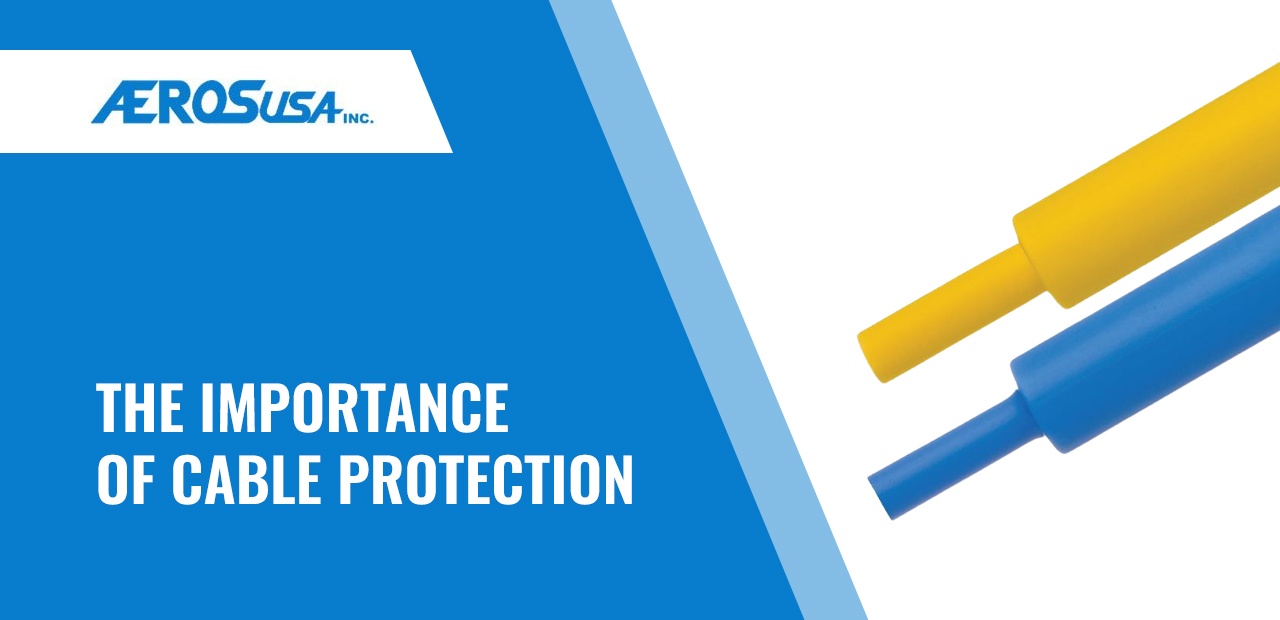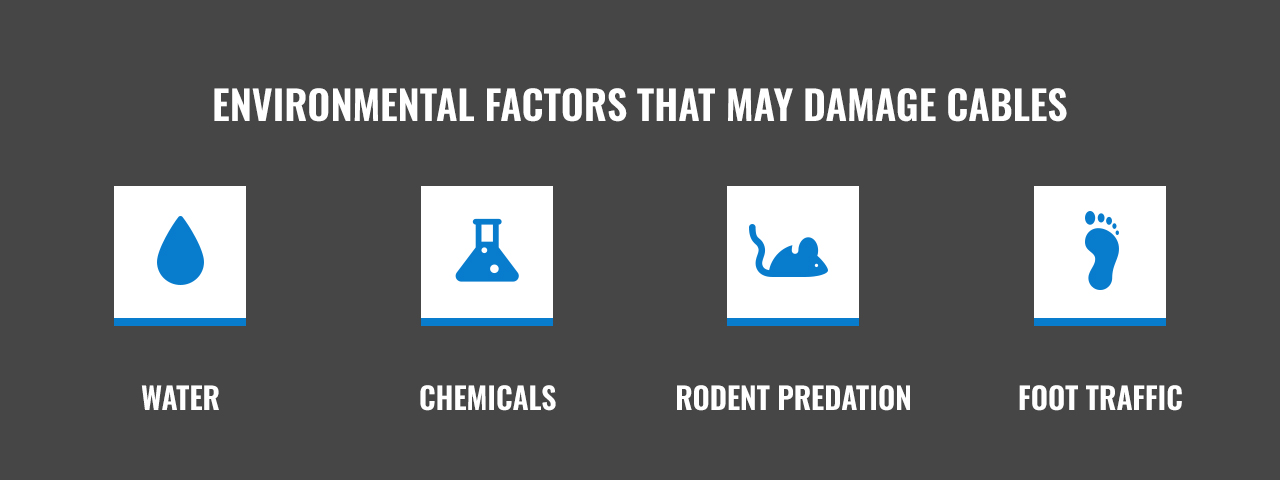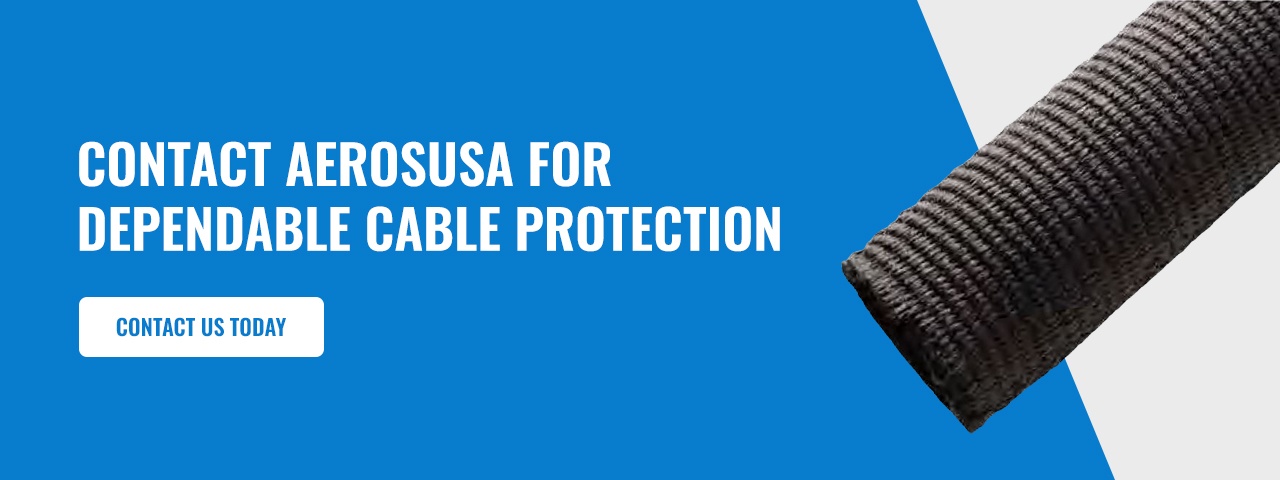
If your business uses cables, reliable cable protection is vital to your productivity, safety and success. Your cables take a beating from environmental and operational stresses, yet they have little built-in protection to shield their thin wires and sheaths from damage. You need high-quality, heavy-duty buffers against impacts, sunlight, high temperatures, chemical exposure, moisture and other stressors, and durable cable protectors are here to meet that need.
Table of Contents
The Effects of Operational Demands on Cables
Cables undergo significant strain during their lifetime, which causes them to degrade. Once they have deteriorated to the point where they can no longer perform their functions or are unsafe for use, they usually require complete replacement. If the operational demands are particularly severe, the cables wear out more quickly and need replacement sooner, leading to higher expenses and lost time for the repair work.
How do the demands on cables relate to the importance of cable protection? The rigors of operational stresses on cables make choosing the correct cable protection critical. Reducing operational stress with cable protection lowers costs, improves sustainability by reducing waste and improves the cables’ durability and longevity.
Rigorous operational demands cause various types of wear and tear on industrial cables. Let’s discuss a few of those.
- Mechanical demands: Mechanical demands constitute the primary demands on most cables. Cables in many applications — from factory machines to passenger trains to military equipment and transportation — undergo mechanical stresses like pushing, pulling, twisting, abrasion and even gnawing by rodents. These demands easily damage unprotected cables.
- Thermal demands: Thermal demands occur when cables become exposed to excessively high or low temperatures. For instance, in steel foundries and glass factories, heat radiation, sparks, high ambient temperatures and splashes of molten metal or glass quickly damage exposed cables. The cables may melt, burn or set the wiring on fire. In below-freezing temperatures, the cable sheathings could crack.
- Chemical demands: High chemical demands on cables most often occur in settings like petroleum refining, pharmaceutical manufacturing, food and beverage production and offshore industries. These industries use aggressive chemicals that can rapidly erode cable sheaths and damage the wiring, causing severe machine, process and installation failure. Cables used in these sectors typically require chemical-resistant cable protection.
- UV/sunlight demands: Cables used outdoors in direct sunlight often sustain ultraviolet ray damage. The rate of degradation corresponds to the length of the exposure and the intensity of the light. Cables used in these scenarios require cable protection specifically designed to resist UV radiation.
Environmental Factors That May Damage Cables

Environmental factors can also play a significant role in cable damage. Below are a few of the most common environmental factors that cause cables to deteriorate.
- Water: Water and electricity decidedly do not mix. When cables become exposed to water or excessive moisture — often because of flooding or high humidity in the atmosphere — they may develop mildew or begin to corrode. If the cables degrade to the point where water comes into contact with the wiring, they can cause electrical shorts, malfunctions and fires.
- Chemicals: Chemical hazards may occur because of the operational conditions of the application using the cables, or chemicals may merely be a background presence in the surrounding environment. Perhaps your business does not make aggressive use of chemicals in its everyday operations, using them only once in a while for painting, cleaning or other ancillary functions. Over time, this intermittent chemical use near your cables can add up to slow cable degradation.
- Rodent predation: The presence of rodents in the environment poses a hazard for industrial cables. These furry pests often find electrical cables irresistible because they can gnaw on the cables to sharpen their teeth or chew through the sheath and wiring and use them as nesting materials. Even modest rodent populations can quickly damage cables, potentially causing broken equipment, malfunctioning rail lines, fires and explosions. Rodent-resistant braided sleeving is an invaluable component of any pest-protection strategy.
- Foot traffic: Foot traffic around your cables may seem innocuous, but it can have adverse impacts on durability and performance over time. People who step on exposed cables may weaken them. Those who trip on cables may tear or crack them with the force of the impact. Protecting cables from the wear and tear of footsteps increases their longevity, safety and performance.
Cable Protection Options
Fortunately, your company has dependable options for precautions against cable damage. At AerosUSA, we supply several durable solutions to keep your cables safe from operational and environmental stresses and protect your equipment from failure.
Below are a few typical cable protection options that may work well for your applications.
- Braided sleeving: Braided wire and cable protection consists of braided polyamide, woven polyester or braided Fiberglas with a silicone rubber coating. These braided sleeves offer exceptional flexibility for applications like robotics, along with mechanical, thermal and abrasion resistance. Their design sometimes specifically protects against rodent damage.
- Corrugated loom: As a cable protector, corrugated loom is similar to corrugated conduits, though it is generally smaller. It is ideal for durable cable protection in contained indoor environments.
- Heat-shrink tubing: Heat-shrink wrapping consists of plastic tubing that the manufacturer has placed around the cables and then shrunk with a heat gun or blowtorch. The plastic then forms a durable, form-fitting, chemical- and UV-resistant casing. This tubing’s advantage is that it resists strain exceptionally well and is highly maneuverable in tight spaces. Your business might choose a 2-to-1 ratio or a tighter 4-to-1 ratio for even more compact protection.
- Vinyl tubing: Polyvinyl chloride tubing often serves as jacketing for liquid-tight metal conduits. The vinyl exterior provides an impenetrable external barrier that rebuffs liquids and prevents moisture damage to the cables inside, though it is less flexible and takes longer to assemble than polyamide tubing.
- Conduits: Electrical conduits are flexible, resilient, corrugated cylindrical protectants that encase your cables to protect them from damage. At AerosUSA, we offer light and durable protective plastic conduits, sturdy protective metal conduits and protective metal liquid-tight conduits designed to protect against moisture damage. We also supply highly versatile polyamide ROHRflex conduits that provide heat and chemical resistance in even the harshest industrial environments. Whether you need UV protection, impact protection, chemical and thermal protection or a combination of defenses, you can find the best conduit construction to meet your requirements.
Contact AerosUSA for Dependable Cable Protection
To see the benefits of durable cable protection in your applications, partner with AerosUSA for trusted solutions.
We offer an extensive catalog of cable concealers, protectors and accessories. Our innovative products are quick and easy to install, and they are versatile enough to handle numerous industrial environments. They provide superior longevity and protection, and our friendly, knowledgeable cable protection experts are always here to respond if you have questions.
Contact us today to purchase cable protection or learn more.


